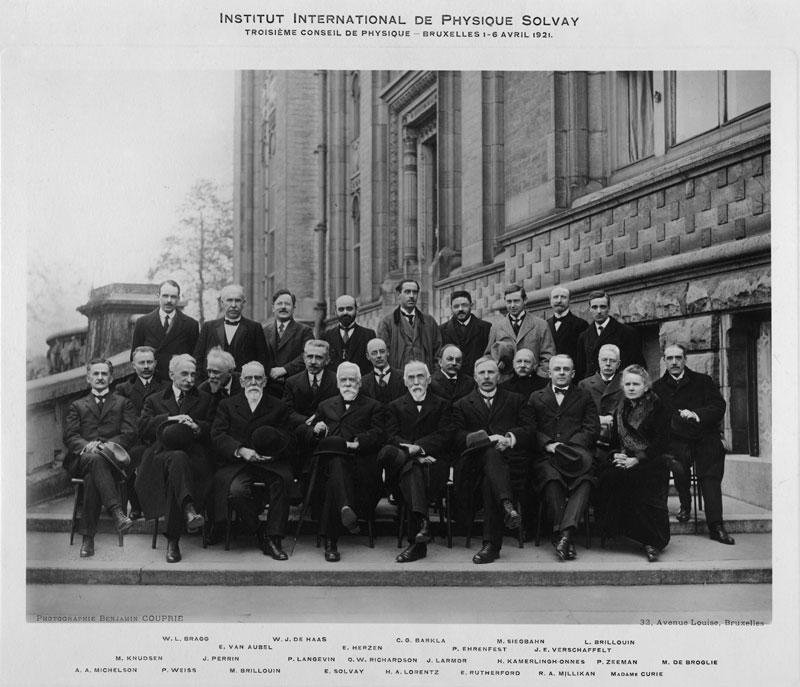
During the decades that bridged the 19th and 20th century, the study of physics transitioned from classical to modern. One of the more notable figures working in this period was Joseph Larmor, an Irish and British physicist and mathematician.
Larmor’s Early Life and Education
Joseph Larmor was born in Magheragall, Ireland (modern-day Northern Ireland), on July 11, 1857. His family soon relocated to Belfast, where Larmor pursued his passion for mathematics and experimental science at Queen’s College, Belfast (modern-day Queen’s University Belfast). Larmor then headed to England to study the intensely competitive Mathematical Tripos examination course at St. John’s College, a constituent college of the University of Cambridge. Notably, he graduated as the Senior Wrangler, or top mathematics undergraduate at Cambridge that year, beating out J.J. Thomson, the physicist credited with the discovery of the electron.

Joseph Larmor. This work is in the public domain in its country of origin and other countries and areas where the copyright term is the author’s life plus 70 years or less, via Wikimedia Commons.
After graduating, Larmor moved into academia and worked as a professor of Natural Philosophy at Queen’s College, Galway, (now the University of Galway) until 1885. Larmor then returned to St. John’s College, where he would stay for the majority of his academic career, to accept a lectureship in mathematics. In 1892, he was elected a Fellow of The Royal Society of London, the United Kingdom’s national academy of sciences, and was later made an Honorary Fellow of the Royal Society of Edinburgh.
Larmor wrote on topics ranging from electricity and dynamics to the electron theory of matter and was often published in the Proceedings of the Royal Society, the main research journal of The Royal Society. It was in this journal that Larmor published his three-part series of papers titled: A Dynamical Theory of the Electric and Luminiferous Medium. These papers contained Larmor’s thoughts on the existence of a medium known as “the aether” and would find their way into his most notable work years later.
Aether and Matter and Modern Physics
Prior to the discovery of the photon, the dominant understanding of electromagnetism was that electromagnetic radiation consisted of waves, and that these waves needed a medium through which to propagate. This medium, known as the “luminiferous aether” or “ether”, was said to be weightless and transparent, and Larmor was a staunch supporter of its existence. He wrote on this subject frequently and suggested that the aether could be represented as a perfectly incompressible and elastic homogenous fluid.
However, by the end of the 19th century, scientists began to investigate this medium more thoroughly. In particular, experiments were developed under the belief that the general movement of the aether would have an impact on the speed of electromagnetic waves. As is understood now (but wasn’t clear then), these waves travel at a constant speed, and so the investigations failed to produce results that supported the theory. Pivotal among these investigations was the 1887 Michelson–Morley experiment, which sought to identify the relative motion of matter through the aether by comparing the speed of light (i.e., electromagnetic waves) in perpendicular directions. The experiment failed to find a significant difference between the speed of light through the presumed aether and the speed at right angles.
With the aether theory struggling to hold weight, Larmor wrote his most popular work Aether and Matter, a culmination of the papers he had previously published. Broadly speaking, this work aimed to clear up the failings of previous experiments and provide potential explanations to support the existence of the aether.

A 1900 copy of Joseph Larmor’s Aether and Matter. This work is in the public domain in its country of origin and other countries and areas where the copyright term is the author’s life plus 70 years or less, via Wikimedia Commons.
Alongside the work of Hendrik Lorentz and Henri Poincaré, Larmor’s book pushed classical physics as far as it could go and helped lay the groundwork for the development of the special theory of relativity. Larmor obtained the full Lorentz transformations, predicted time dilation, and verified that the phenomenon of length contraction should occur for bodies whose atoms were held together by electromagnetic forces. However, he was unable to develop a sufficient explanation to conclusively support the existence of an aether.
In 1905, Albert Einstein found that there was no logical need to assume the existence of an aether in order to arrive at the Lorentz transformations. With this revelation, Einstein proposed his special theory of relativity and asserted that the laws of physics were invariant and the speed of light in a vacuum was the same for all observers. This theory was quickly adopted, and the notion of an aether was generally discarded. The proposal of this theory stands as one of the transitional markers between classical and modern physics — and would not have been discovered without the work of Larmor, Lorentz, and Poincaré.
A Distinguished Career
Outside of this debate, Larmor continued to rise to prominence in the world of academia and was appointed Lucasian Professor of Mathematics at Cambridge in 1903. This position, which he would hold until his retirement in 1932, remains one of the most prestigious academic posts in the world, having been held by the likes of Sir Isaac Newton and, later, Stephen Hawking. Larmor added a knighthood to his list of achievements in 1909 and was elected a Member of Parliament for Cambridge University in 1911.

The Third Solvay Conference on Physics, Brussels, 1921. This work is in the public domain in the United States via Wikimedia Commons.
While Lucasian Professor, Larmor was an invited speaker at the International Congress of Mathematics at Strasbourg in 1920 and in Toronto four years later. He also attended the Solvay Conference in 1921, the third such conference devoted to unsolved problems in physics and chemistry. Other eminent attendees included Marie Curie, Lorentz, and Ernest Rutherford.
Larmor’s Legacy
Though remembered for his conservative attitude toward new ideas, Larmor has been credited with creating one of the first solar system models of the atom, being one of the first to mention the existence of electrons, and being the first to calculate the rate of energy radiation from an accelerating electron. For his work and his impact, multiple terms bear his name:
- The Larmor Precession — the precession of the magnetic moment of an object about an external magnetic field
- The Larmor Formula — a formula used to calculate the total power radiated by a nonrelativistic point charge as it accelerates
Larmor also had a great respect for the legacy of scientists that came before. This included writing obituaries for George Stokes, Josiah Willard Gibbs, and William Thomson (Lord Kelvin).
Further Reading
- Learn about designing and optimizing MRI birdcage coils using simulation, which involves finding the optimal magnetic field for the surrounding air at a desired Larmor frequency.
- Explore the life and work of other scientists who made great contributions to the study of physics:
- Hendrik Lorentz, a Dutch physicist who clarified the concept of the electron within an atom
- Clinton Davisson, an American physicist best known for his discovery of electron diffraction
- Niels Bohr, a Danish physicist whose strides toward understanding quantum theory and atomic structure earned him the Nobel Prize in Physics in 1922





Comments (0)